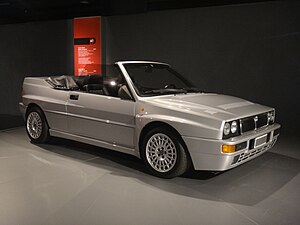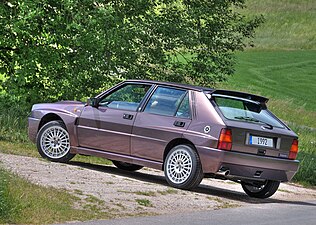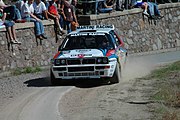Lancia Delta
| Lancia Delta | |
|---|---|
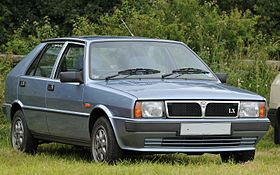 Lancia Delta LX 1.3 (first generation, 1986–91 model) | |
| Overview | |
| Manufacturer | Lancia |
| Production | 1979–1999 2008–2014 |
| Body and chassis | |
| Class | Small family car Rally car (C) |
| Body style | Hatchback |
| Chronology | |
| Predecessor | Autobianchi A111 Autobianchi Primula |
The Lancia Delta is a small family car produced by Italian automobile manufacturer Lancia in three generations. The first generation produced between 1979 and 1994, the second generation from 1993 to 1999, and the third generation from 2008 to 2014.
The Delta was first shown at the Frankfurt Motor Show in 1979.[1] The Delta dominated the World Rally Championship during the late 1980s and early 1990s. The homologation requirements of Group A regulations meant marketing road-going versions of these competition cars — the Lancia Delta HF 4WD and HF Integrale. A total of 44,296 Integrales were produced.[2]
First generation
| First generation | |
|---|---|
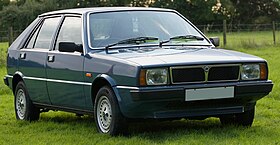 1982 Delta 1500 | |
| Overview | |
| Also called | Saab-Lancia 600 |
| Production | 1979–1994 |
| Designer | Giorgetto Giugiaro at Italdesign |
| Body and chassis | |
| Body style | 5-door hatchback |
| Layout | Transverse front-engine, front-wheel-drive or four-wheel-drive |
| Related | Lancia Prisma |
| Powertrain | |
| Engine |
|
| Transmission | |
| Dimensions | |
| Wheelbase | 2,475 mm (97.4 in) |
| Length | 3,885 mm (153.0 in) (1979–82) 3,895 mm (153.3 in) (1982–94) |
| Width | 1,620 mm (63.8 in) |
| Height | 1,380 mm (54.3 in) 1,355 mm (53.3 in) |
| Kerb weight | 955–1,340 kg (2,105–2,954 lb) |
The first Delta (Tipo 831) was a five-door hatchback, designed by Giorgetto Giugiaro and released in 1979. Between 1980 and 1982, it was also sold in Sweden by Saab Automobile, badged as the Saab-Lancia 600. The Delta was voted the 1980 European Car of the Year.
A special Delta HF Integrale version was a four-wheel drive hot hatch with a turbocharged petrol engine. Modified versions of the HF dominated the World Rally Championship, scoring 46 WRC victories overall and winning the Constructors Championship a record six times in a row from 1987 to 1992, in addition to Drivers' Championship titles for Juha Kankkunen (1987 and 1991) and Miki Biasion (1988 and 1989).
The Lancia Delta S4, which the works team ran immediately prior to the HF 4WD and Integrale models' world championship careers from the season-ending 1985 RAC Rally until the end of the 1986 season, while sharing the same name and appearance, was a Group B race car designed and built specifically for rallying, and was entirely different from the mass-produced consumer versions.
History
Development
The car that would become the Delta during its development went by the project codename Y 5,[3] was conceived as an upmarket front-wheel drive small family car positioned below the larger Beta; an offering around four meters in length had been absent from Lancia's lineup since the demise of the Fulvia Berlina in 1973. Design was by Giorgetto Giugiaro's Italdesign. Its platform put together MacPherson suspension developed for the Beta with four-cylinder, SOHC engines derived from the Fiat Ritmo. The Fiat engines were revised by Lancia engineers with a Weber twin-choke carburettor, a new inlet manifold, exhaust system and ignition. To achieve its market positioning the Delta offered features uncommon in the segment, as fully independent suspension, rack and pinion steering, available air conditioning, optional split-folding rear seat, height-adjustable steering wheel, and defogger.[4] Its three-piece body-coloured bumpers made from polyester resin sheet moulding compound were claimed by Lancia to be a first in the industry. The heating and ventilation were developed with help from Saab, experts in the field.[5]
Debut
Whilst details about the car were known since the spring,[3] the Lancia Delta was unveiled to the public at the September 1979 Frankfurt Motor Show,[6] At launch three models were offered: the base Delta 1300 4-speed, with a 1,301 cc 75 PS engine and simplified equipment, Delta 1300 5-speed, which added more features and an overdrive fifth gear for cruising, and Delta 1500, with a 1,498 cc 85 PS engine and a 5-speed gearbox. The Delta was met with warm reception at the Frankfurt unveiling by the Italian press and by the German one[7] to booth; in December it was awarded the Car of the Year 1980 recognition by a jury of 53 automotive journalists from 16 European countries.[8]

Sales started in October 1979; 43,000 were sold in 1980, and by the end of 1981 production had exceeded 100,000.[9] At the beginning of 1982 as an automatic transmission option was added, the 1500 Automatica; its 3-speed was built by Lancia in the Verrone plant and was already being installed on Betas.[10] In March the top-of-the-line 1500 LX trim level joined the lineup; it featured extended convenience equipment, metallic paint, 14-inch alloy wheels penned by Giugiaro and wool cloth upholstery in a chequered fabric specially designed by Italian fashion house Zegna.[11] Two months after the trim level was extended to the 1.3-litre engine too, which simultaneously increased its output to 78 PS thanks to a raised compression ratio and electronic ignition.[12]
1982 facelift

November 1982 brought the first facelift for the Delta.[13] The bumpers were changed from three-piece sheet moulded compound to one-piece thermoplastic polymer, the front one was redesigned with a more prominent lower spoiler; another aerodynamic addition was a flat body-colour spoiler applied to the rear part of the roof. Other changes included the deletion of the anodised fascia between the rear tail lights and a 40 kg weight reduction on all models. Inside there were new seats and, on the range topping models, an optional digital trip computer. Concurrently the Delta GT 1600 was launched,[13] the car's first sporting variant. It was powered by a 1585 cc, 105 PS DOHC engine with Marelli Digiplex ignition; lower profile tyres, retuned suspensions and disk brakes on all four wheels completed the package. Standard equipment was the richest available and some optionals like air conditioning were exclusive to the GT; the cabin was upholstered in Zegna cloth. Outside details like a "GT" badge on the right side of the grille, matte black door handles and window trim distinguished it from other Deltas. As the 5-speed 1500, 4-speed 1300 and LX versions were dropped — the latter only to be reintroduced in April 1984 on the 1300 LX, with revised equipment—the range was now composed of three models. On 9 March 1984 the 200,000th Delta left the Chivasso factory.[14]
Delta HF

The first performance Delta was the Delta HF, which was introduced in July 1983 and went on sale in September[15] after a first appearance at the Frankfurt Motor Show.[16] the HF acronym—last used on the Stratos—stood for "High Fidelity", and had been used on performance version of Lancia cars since 1966.[17] It was front-wheel drive and powered by a turbocharged version of the 1.6-litre engine from the Delta GT; the system used a Garrett TBO- 225 turbocharger with wastegate valve, an air-to-air heat exchanger, a blow-through twin-choke Weber carburetor and Marelli Microplex ignition with pre-ignition control. To withstand the additional stress deriving from turbocharging upgrades were made to the oil system, with increased capacity and an oil cooler, and to the heads with sodium-filled valves. The gearbox was a ZF 5-speed unit. Dampers, springs and steering were retuned, and the tyres were wide 175/65 Michelin TRX on R 340 alloy wheels. In true Lancia tradition the exterior of the HF was relatively understated: changes were limited to silver "HF" badging on the grille, a deeper chin spoiler, black trim as on the GT, black roof drip rail mouldings, black side skirts with small silver "turbo" badges in front of the rear wheels, the 1982 roof spoiler painted in black, air intake cowls on the bonnet grilles, bronze-tinted athermic glass and 8-spoke alloy wheels. The cabin featured a leather-covered steering wheel and supplementary digital instrumentation with bar indicators; the upholstery material was the usual Zegna fabric, and Recaro sport seats covered in the same cloth optional. About ten thousand Delta HF were made, in a two-year production period.[18]
A special limited edition of the HF, named HF Martini, was launched at the March 1984 Geneva Motor Show.[19] To celebrate the rally victories of the Lancia-Martini Rally 037 it was painted white with a Martini stripe on the sides below the door handles, and carried Martini-coloured badging; Recaro sport seats were standard. Only 150 were produced between 1984 and 1985.
Delta HF turbo
In October 1985 Lancia unveiled alongside the road-going Delta S4 a new version of the HF, renamed Delta HF turbo[18] in view of the four-wheel-drive HF début awaited after the next summer. To address some criticisms[20] the car was given less subdued styling features and more generous equipment to differentiate it from the other Deltas: red "HF turbo" scripts on the grille, the side skirts and the rear hatch, a three-spoke sport steering wheel, dual wing mirrors, a two-colour pinstripe along the mid-bodyside character line and Pirelli P6 tyres on 14-inch Cromodora alloy wheels with a new 8-hole design. Price, technical specifications and performance remained mostly unchanged. When in later years the more powerful, four-wheel-drive HF models were introduced the HF turbo remained on sale alongside them.
1986 facelift

The HF turbo soon lost its crown as top-of-the-range Delta, as the turbocharged 2.0-litre and four-wheel drive Delta HF 4WD was unveiled at the April 1986 Turin Motor Show. Some of the features of the HF 4WD previewed a major mid-cycle refresh for the entire Delta range, announced in May 1986 and put on sale in June.[21][22] New enveloping bumpers—the front one with provisions for integrated fog lights—gave the car a more modern look; the entire front end was changed with a new grille and new headlight covers, which were slanted forward and protruded from the bodywork in an effort to make the car more aerodynamic. The roof spoiler introduced in 1982 was removed. Seven models composed the 1986 range: 1.3, LX 1.3, 1.5 Automatica, GT i.e., HF turbo, HF 4WD and turbo ds. Entry-level model was the 1.3; the 1,301 cc engine had revised intake and exhaust system, fuel cut-off, a new carburettor and breakerless ignition. It was also available on the more upscale LX 1.3. Similar changes were made to the powertrain of the Delta 1.5 Automatica. The Delta GT and HF turbo were given Weber IAW integrated electronic ignition and fuel injection system to become the Delta GT i.e. and the Delta HF turbo i.e., with 108 PS and 140 PS respectively. Deeper changes had been made to the GT i.e. engine: the cylinder head had been rotated 180°, bringing the exhaust side to the front for better cooling, and the whole engine was canted forward 18° to lower its centre of gravity. Delta HF turbo was updated to HF 4WD looks and interior, from which it differed mainly for the square headlights and single exhaust. Delta turbo ds marked the introduction of the first diesel engine on the Delta. This was a 1,929 cc 8-valve four-cylinder from the Prisma, with an output of 80 PS; it used a KKK turbocharger with wastegate valve, an intercooler and an oil cooler. The turbo ds was positioned on the market like the GT i.e., and given similarly complete standard equipment comprising such features as an oil pressure gauge, boost pressure gauge and power steering.
In September 1987 the HF 4WD was replaced by the more capable Delta HF integrale, which in turn evolved into the 16-valve Delta HF integrale 16v in March 1989.
A new sporty trim level for the 1.3 was added in May 1990, the Delta Personalizzata, available in red or white with contrasting twin pinstripe and electric blue cloth upholstery; standard equipment comprised body-colour wing mirrors, tachometer, clock and sport steering wheel.[23] Later that year the turbo ds, GT i.e. and HF turbo benefited of extended standard equipment, new velour and Alcantara trim; leather Recaro seats became available on the HF integrale.[24]

1991 revisions
In June 1991 the last update of the Delta went on sale, almost twelve years after its 1979 début.[25] The front-wheel drive range was reduced to three models, LX, GT i.e. and HF turbo; all three of them had gained body-colour side skirts, dual body-colour wing mirrors, athermic glass, electric windows and seat belts. LX and GT i.e. donned a chrome grille, the louvered bonnet from the HF integrale 8v and optional 8-spoke diamond-cut alloy wheels from the Dedra. Updated colour and trim included green and blue "Metallescente" mica paint and glen plaid cloth upholstery. The Delta LX abandoned the 1.3 in favour of a revised version of the 1.5-litre engine. Dual round headlights and the domed, vented bonnet from the HF integrale 16v made the HF turbo look almost like an HF integrale. [26]
As the second generation was ready to be launched in 1993, after a career of 13 years the front-wheel drive Delta was phased out at the end of 1992. Production of the HF integrale would continue for two years more.
Four-wheel-drive HF variants
HF 4WD
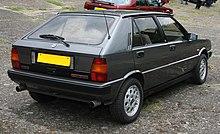
Group B rallying was dropped at the end of the 1986 season, but the Delta HF 4WD was not suited to Group A rallying. The Delta HF Turbo became the road car top of the Delta range. There is very little to distinguish the car from the earlier 'Turbo i.e.' apart from the four-headlight system, fog lamps mounted in the front spoiler, 4WD badging on the rear hatch, small side skirts and two raised air intakes on the bonnet (hood). The later car is therefore virtually indistinguishable from the 1.6-litre HF Turbo i.e.
In the Delta HF 4X4, Lancia opted for a four-wheel drive system with an in-built torque-splitting action. Three differentials were used. Drive to the front wheels is linked through a free-floating differential; drive to the rear wheels is transmitted via a 56/44 front/rear torque-splitting Ferguson viscous-coupling-controlled epicyclic central differential. At the rear wheels is a Torsen (torque sensing) rear differential. It divides the torque between the wheels according to the available grip, with a maximum lockup of 70%.
The basic suspension layout of the Delta 4WD remains the same as in the rest of the two-wheel drive Delta range: MacPherson strut–type independent suspension with dual-rate dampers and helicoidal springs, with the struts and springs set slightly off-centre.
The suspension mounting provided more isolation by incorporating flexible rubber links. Progressive rebound bumpers were adopted, while the damper rates, front and rear toe-in and the relative angle between springs and dampers have all been altered. The steering was power-assisted rack and pinion.
Integrale 8v

The Lancia HF Integrale incorporated some of the features of the Delta HF 4WD into a road car. The engine was an 8-valve 2 L fuel injected 4-cylinder, with balancing shafts. The HF version featured new valves, valve seats and water pump, larger water and oil radiators, more powerful cooling fan and bigger air cleaner. A larger capacity Garrett T3 turbocharger with improved air flow and bigger inter-cooler, revised settings for the electronic injection/ignition control unit and a knock sensor, boost power output to 185 bhp (DIN) (136 kW) at 5300 rpm and maximum torque of 31 m·kgf (304 N·m, 224 lbf·ft) at 3500 rpm.
The HF Integrale had permanent 4-wheel drive, a front transversely mounted engine and five-speed gearbox. An epicyclic centre differential normally splits the torque 56 per cent to the front axle, 44 per cent to the rear. A Ferguson viscous coupling balanced the torque split between front and rear axles depending on road conditions and tyre grip. The Torsen rear differential further divides the torque delivered to each rear wheel according to grip available. A shorter final drive ratio (3.111 instead of 2.944 on the HF 4WD) matched the larger 6.5x15 wheels to give 24 mph/1000 rpm (39 km/h per 1000 rpm) in fifth gear.
Braking and suspension were uprated to 284 mm (11.2 in) ventilated front discs, a larger brake master cylinder and servo, as well as revised front springs, dampers, and front struts.
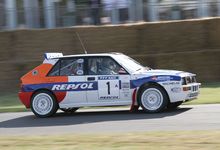
The HF Integrale was facelifted with bulged wheel arches for the wider section 195/55 VR tyres on 15-inch 6J alloy wheels. A new bonnet incorporated air louvres while the restyled bumpers wrapped around to meet the wheel arches at front and rear. The front bumper, now wider, incorporates air intakes and for the rectangular auxiliary driving lights. The side skirts are faired into the wheel arches at front and rear and the twin rear view mirrors are finished in body colour. There were only 50 RHD factory built cars, none of which were officially imported to the UK.
Integrale 16v

The 16v Integrale was developed for rallying, introduced at the 1989 Geneva Motor Show,[27] and made a winning debut on the 1989 San Remo Rally.
It featured a raised centre of the bonnet to accommodate the new 16 valve engine, as well as wider wheels and tyres and new identity badges front and rear. The torque split was changed to 47% front and 53% rear.
The turbocharged 2-litre Lancia 16v engine produced 200 bhp (149 kW) at 5,500 rpm, for a maximum speed of 137 mph (220 km/h) and 0–100 km/h (0-62 mph) in 5.7 seconds. Changes included larger injectors, a more responsive Garrett T3 turbocharger, a more efficient intercooler, and the ability to run on unleaded fuel without modification.
Integrale Evoluzione

The first Evoluzione cars were built at the end of 1991 and through 1992. These were to be the final homologation cars for the Lancia Rally Team; the Catalytic Evoluzione II (below) was never rallied by the factory.
The Evoluzione I had a wider track front and rear than earlier Deltas.[1] The bodyside arches were extended and became more rounded. The wings were now made in a single pressing. The front strut top mounts were also raised, which necessitated a front strut brace. The new Integrale retained the four wheel drive layout. The engine was modified to produce 210 PS (207 bhp; 154 kW) at 5,750 rpm and 298 N⋅m (220 lb⋅ft) of torque at 3,500 rpm. [28]
External changes included: new grilles in the front bumper to improve the air intake for engine compartment cooling; a redesigned bonnet (hood) with new lateral air slats to further assist underbonnet ventilation; an adjustable roof spoiler above the tailgate; new five-bolt wheels with the same design of the rally cars; and a new single exhaust pipe.
Interior trim was now grey Alcantara on the Recaro seats, as fitted to the earlier 16V cars; leather and air conditioning were offered as options, as well as a leather-covered Momo steering wheel.
Integrale Evoluzione II
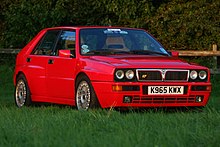
Presented in June 1993, the second Evolution version of the Delta HF Integrale featured an updated version of the 2-litre 16-valve turbo engine to produce more power, as well as a three-way catalyst and Lambda probe.[27] A Marelli integrated engine control system with an 8 MHz clock frequency which incorporates:
- timed sequential multipoint injection;
- self-adapting injection times;
- automatic idling control;
- engine protection strategies depending on the temperature of intaken air;
- Mapped ignition with two double outlet coils;
- Three-way catalyst and pre-catalyst with lambda probe (oxygen sensor) on the turbine outlet link;
- Anti-evaporation system with air line for canister flushing optimised for the turboengine;
- New Garrett turbocharger: water-cooled with boost-drive management i.e. boost controlled by feedback from the central control unit on the basis of revs/throttle angle;
- Knock control by engine block sensor and new signal handling software for spark park advance, fuel quantity injected, and turbocharging;
The engine developed 215 PS (158 kW) DIN (against 210 PS on the earlier uncatalysed version) and maximum torque of 32 kgf·m (314 N·m) (formerly 31 kgf·m or 300 N·m).
The 1993 Integrale received a cosmetic and functional facelift that included.
- new 16" light alloy rims with 205/45 ZR 16 tyres;
- body colour roof moulding to underline the connection between the roof and the Solar control windows;
- aluminium fuel cap and air-intake grilles on the front mudguards;
- red-painted cylinder head;
- new leather-covered three-spoke MOMO steering wheel.
- standard Recaro seats upholstered in beige Alcantara with diagonal stitching.
Limited editions and specials
Lancia produced several limited and numbered editions models based on the Delta HF Integrale "Evoluzione", each offering unique exterior and interior colours, materials and equipment. Some were put on general sale, while others were reserved to specific markets, owners clubs or selected customers. The following table lists all of the limited editions and their main features.
| Lancia Delta HF Integrale limited editions | |||||||
|---|---|---|---|---|---|---|---|
| Name | Image | Intr. date | Base model | Paint colour | Special exterior features | Production and notes | |
| Upholstery | Special interior features | ||||||
| Martini 5[29] |  |
01/1992 | "Evo" | white |
|
Celebrating five consecutive WRC titles. 400 made. | |
| black Alcantara with red stitching |
| ||||||
| Club Italia |  |
1992 | "Evo" | dark blue |
|
Reserved to Club Italia members. 15 made. | |
| bordeaux red leather |
| ||||||
| "Verde York"[30] |  |
1992 | "Evo" | dark green | — | 602 made.[31] | |
| beige leather with green stitching |
| ||||||
| Martini 6[32] |  |
12/1992 | "Evo" | white |
|
Celebrating six consecutive WRC titles. 310 made. | |
| turquoise Alcantara with red stitching |
| ||||||
| "Giallo Ginestra"[33] |  |
10/1993 | "Evo 2" | broom yellow | — | 220 made. Allocation: 150 Italy, 50 Germany, 20 France. | |
| black Alcantara with yellow stitching |
| ||||||
| "Bianco Perlato" |  |
1993 | "Evo 2" | pearl white |
|
||
| blue leather |
| ||||||
| "Blu Lagos" |  |
1994 | "Evo 2" | metallic blue |
|
||
| straw yellow leather |
| ||||||
| Club Hi.Fi.[34][35] |  |
4/1994 | "Evo 2" | Monza red or Lancia blue |
|
Reserved to Club Hi.Fi. members. 20 made. | |
| black or beige leather |
| ||||||
| Club Lancia |  |
1994 | "Evo 2" | Monza red or Lancia blue |
|
Reserved to Club Lancia members. 7 made. | |
| black or beige leather |
| ||||||
| Dealers collection[36][37] |  |
1994 | "Evo 2" | pearl red | — | Reserved to Lancia dealers. | |
| beige leather |
| ||||||
| Edizione finale[36][37] |  |
1994 | "Evo 2" | Amaranto (dark red) | Japanese market only. Livery from the Lancia Fulvia HF. 250 made. | ||
| black Alcantara and cloth | As Dealers Collection, plus:
| ||||||
A notable one-off model was the Lancia Delta Spider Integrale, a two-door convertible built for Fiat president Gianni Agnelli.[38]
After production had finished in 1994, Bruno Maggiora tried to convince Lancia to continue the Delta with a third evolution which was realized in the Delta HF Integrale "Viola", the one and only "Evo 3" car named by its intense violet color. The concept features a new injection system, an IAW P8 ECU and an increase in boost for the Garrett T3 turbocharger, boosting power from 215bhp to 237bhp at 6,000rpm and 236lb ft of torque. It also features a GKN limited-slip differential, a new clutch for the center differential, a short shift gearchange and revised springs and dampers.[39]
-
Gianni Agnelli's one-off Delta Spider Integrale on display at Museo Nazionale dell'Automobile
-
Lancia Delta "Evo 3" Viola, one-off
Performance
Performance of the first generation models:[27], [40]
| Model | Year | Displacement | Power | Torque | Accel. 0–100 km/h,s |
Top speed | |||||||
|---|---|---|---|---|---|---|---|---|---|---|---|---|---|
| cc | cu in | PS | kW | hp | @ rpm | N·m | lb·ft | @ rpm | km/h | mph | |||
| 1.1 (Greece only) | 1,116 | 68.1 | 64 | 47 | 63 | 5800 | 85 | 63 | 3500 | — | — | — | |
| 1.3 | 1,301 | 79.4 | 75 | 55 | 74 | 5800 | 105 | 77 | 3500 | 15.0 | 160 | 99 | |
| 1.5 | 1,498 | 91.4 | 85 | 63 | 84 | 5800 | 123 | 91 | 3500 | 12.5 | 161 | 100 | |
| 1.6 GT | 1,585 | 96.7 | 105 | 77 | 104 | 5800 | 136 | 100 | 3300 | 10.0 | 180 | 112 | |
| 1.6 GT.i.e. | 1,585 | 96.7 | 108 | 79 | 107 | 5900 | 137 | 101 | 3500 | 9.8 | +185 | 115 | |
| 1.6 HF Turbo | 1984 | 1,585 | 96.7 | 130 | 96 | 128 | 5600 | 191 | 141 | 3700 | 195 | 121 | |
| 1.6 HF Turbo | 1985 | 1,585 | 96.7 | 140 | 103 | 138 | 5500 | 191 | 141 | 3500 | 8.7 | 203 | 126 |
| HF4WD | 1986 | 1,995 | 121.7 | 165 | 121 | 163 | 5500 | 285 | 210 | 2750 | 7.8 | 208 | 129 |
| HF Integrale 8v | 1987 | 1,995 | 121.7 | 185 | 136 | 182 | 5300 | 304 | 224 | 2500 | 6.6 | 215 | 134 |
| HF integrale 16V | 1989 | 1,995 | 121.7 | 200 | 147 | 197 | 5500 | 298 | 220 | 3000 | 5.7 | 220 | 137 |
| HF integrale "Evo1" | 1991 | 1,995 | 121.7 | 210 | 154 | 207 | 5750 | 298 | 220 | 3500 | 5.7 | 220 | 137 |
| HF integrale "Evo2"[41] | 1993 | 1,995 | 121.7 | 215 | 158 | 212 | 5750 | 314 | 232 | 2500 | 5.7 | 220 | 137 |
| 1.9 TD | 1,929 | 117.7 | 80 | 59 | 79 | 4200 | 172 | 127 | 2400 | 13.8 | 170 | 106 | |
Rallying
The Lancia Delta is one of the most successful rally cars ever, having won the World Rally Championship for manufacturers six times between 1987 and 1992. After the abolition of Group B Lancia was forced, as were all other manufacturers, to compete with Group A cars. The Delta HF4WD was therefore pressed into service for the 1987 season. Despite some flaws it was more suitable for rallying than its rivals and easily won the 1987 championship. The Delta's dominance helped it out in the Italian market at least, where a 42% sales increase in the first half of 1987 was directly attributed to its rallying successes.[42]
Competitors began to emerge during 1988, in response to whom Lancia produced first the Delta Integrale, and then in 1989 the Integrale 16v, which remained competitive until 1991 and netted the team four more world championships. The Evoluzione Delta was introduced for 1992 and won the championship for a record sixth year in succession, before Lancia withdrew from the sport at the end of an unsuccessful 1993 season. Lancia drivers won the drivers' title in 1987, 1988, 1989 and 1991. The four evolutions of the Delta won 46 world championship events between them, and their run of six successive manufacturers' championships remains a world record.
-
Markku Alén at the 1987 RAC Rally
-
Lancia Delta HF Integrale - 2007 Rallye Deutschland
-
Lancia Delta HF Integrale Evoluzione
Saab-Lancia 600

The Saab-Lancia 600 is a rebadged Lancia Delta, sold by Saab after a deal with Lancia.
The deal was a part of the 1980s co-operation between the Swedish car manufacturer Saab and the Italian Fiat Group, which includes Lancia and Alfa Romeo in addition to Fiat. The partnership also resulted in the 'Type 4' project, which provided the common platforms for the Saab 9000, the Lancia Thema, the Fiat Croma and the Alfa Romeo 164.
The 600 was developed because Saab did not have the finances to support the production of entirely new models and looked to other companies in order to replace the compact 96 in their lineup.
The first years it was sold as GLS and the exclusive GLE, but due to poor sales because of the high price tag the GLE-model did not last long. The 600 was offered only with the 1.5-litre engine that had 85 horsepower, connected to a manual five-speed gearbox.
The Saab-Lancia 600 was designed by Giorgetto Giugiaro and, in common with the company's other models, was a front-wheel drive and a hatchback, with a rallying pedigree. The Saab-Lancia 600 version was sold only in Sweden, Finland, and Norway. The last cars were sold in early 1987; Saab then stopped importing Lancias to Sweden and the local Fiat importer took over from 1 January 1988.[43]
Due to the harsh weather conditions of northern Europe Saab developed their own heater, the only modification from the Lancia design. The climate caused rust issues with the car, including holing the fuel tank.[citation needed]
The car is very rare today. In 2012, of the 6419 Saab-Lancias that were produced for the Swedish market, only 159 were left and only 12 were in traffic.[44]
Lancia Hyena
| Lancia Hyena | |
|---|---|
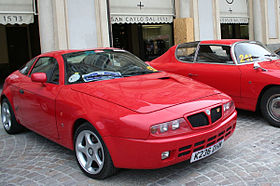 | |
| Overview | |
| Manufacturer | Zagato on Lancia mechanicals |
| Production | 1992–1996 24 made |
| Assembly | Rho, Milan, Italy |
| Designer | Marco Pedracini at Zagato |
| Body and chassis | |
| Class | Sports car (S) |
| Body style | 2-door coupé |
| Layout | Transverse front-engine, four-wheel drive |
| Related | Lancia Delta Integrale "Evoluzione" |
| Powertrain | |
| Engine | 2.0 L I4 (turbocharged petrol) |
| Transmission | 5-speed manual |
The Lancia Hyena was a 2-door coupé made in small numbers by Italian coachbuilder Zagato on the basis of the Delta HF Integrale "Evoluzione".
History
The Hyena was born thanks to the initiative of Dutch classic car restorer and collector Paul V.J. Koot, who desired a coupé version of the multiple World Rally Champion HF Integrale. He turned to Zagato, where Hyena was designed in 1990 by Marco Pedracini. A first prototype was introduced at the Brussels Motor Show in January 1992.[45]
Decision was taken to put the Hyena into limited production. Fiat refused to participate in the project supplying bare HF Integrale chassis, which complicated the manufacturing process: the Hyena had to be produced from fully finished HF Integrales, privately purchased at Lancia dealers. Koot's Lusso Service took care of procuring and stripping the donor cars in the Netherlands; they were then sent to Zagato in Milan to have the new body built and for final assembly. All of this made the Hyena very expensive to build and they were sold for around 140,000 Swiss francs[46] or $75,000 (£49,430).[47]
A production run of 75 examples was initially planned,[46] but only 25 Hyenas were completed between 1992 and 1993.[48]
Specifications
The Zagato bodywork made use of aluminium alloys and composite materials; the interior featured new dashboard, console and door cards made entirely from carbon fibre. Thanks to these weight saving measures the Hyena was some 150 kilograms (330 lb)[46] lighter than the original HF Integrale, about 15% of its overall weight. The two-litre turbo engine was upgraded from 205 to 250 PS (184 kW), and the car could accelerate from 0–100 km in 5.4 seconds.[48]
Concept cars
Italdesign Orca
The Orca was a concept car with aerodynamic 5-door fastback body by Italdesign Giugiaro, unveiled at the April 1982 Turin Motor Show; it was based on the Delta platform, with a turbocharged engine and four-wheel-drive which could be disengaged at speed.[49][50] The concept's goal was to combine a highly aerodynamic shape (drag coefficient of Cd=0.245) with outstanding passenger room for its size.[50]
Lancia HIT
The Lancia HIT (standing for "High Italian Technology") was a concept car with 2+2 coupé body by Pininfarina unveiled at the April 1988 Turin Motor Show.[51] It was based on the mechanicals of the Delta HF Integrale, and bodied using cold glued carbon fibre sandwich panels.[52]
Second generation
| Second generation | |
|---|---|
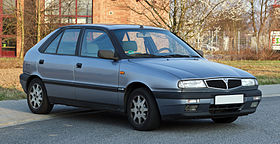 | |
| Overview | |
| Production | 1993–1999 |
| Assembly | Pomigliano d'Arco, Naples[53] |
| Designer | Ercole Spada at I.DE.A[54] |
| Body and chassis | |
| Body style | |
| Layout | Transverse front-engine, front-wheel-drive |
| Platform | Type Two[55] |
| Related | |
| Powertrain | |
| Engine |
|
| Transmission | 5-speed manual |
| Dimensions | |
| Wheelbase | 2,540 mm (100 in) |
| Length | 4,011 mm (157.9 in) |
| Width |
|
| Height | 1,430 mm (56 in) |
| Kerb weight | 1,130–1,330 kg (2,491–2,932 lb) |
The successor to the original Delta, the "Nuova Delta" (Tipo 836)—always referred to by Lancia as Lancia δ with the lower-case Greek letter—was introduced in 1993 and remained in production until 1999. It was designed at Turinese design and engineering studio I.DE.A Institute by Ercole Spada. Based on the "Type Two" platform of the Fiat Tipo, the Nuova Delta was targeted at customers more interested in comfort and convenience. Despite front-wheel drive HF performance variants with up to 193 PS (142 kW; 190 hp) were offered, no four-wheel drive second generation Deltas were even produced.
History
The first generation Delta had been given a second lease of life by its rallying successes, but by the 1990s it was over ten years old and due replacement; its four-door saloon sibling, the Prisma, had already been replaced by the Lancia Dedra. Development and tooling work for the Tipo 836 Delta lasted five years[56] and, according to a statement by Fiat CEO Paolo Cantarella, required an investment of 700 billion Lire.[57] Projected sales numbers were 60,000 a year, half of them exports.[57]
Launch
The second generation Delta's world première was held at the March 1993 Geneva Motor Show, alongside that of the final "Evo 2" HF Integrale.[56][58] Sales commenced in May.[59] Initially the Nuova Delta was offered with three engines and outputs varying from 76 to 142 PS (56 to 104 kW; 75 to 140 hp): an entry level SOHC 1.6-litre, and two DOHC inline fours with Lancia's twin counter rotating balance shafts, an 8-valve 1.8 L and a 16-valve 2.0 L. Trim level were three: base and LE for the 1.6 and 1.8, base and richer LS for two-litre models. The sportier 2.0 HF was also unveiled in Geneva, but went on sale in September; it used a version of the 16-valve 2.0 L equipped with a Garrett T3 turbocharger and an intercooler to produce 186 PS (137 kW; 183 hp).[60] Mechanical changes from the other Deltas included up-sized 205/50 tyres, stiffer suspension, standard 4-way ABS, a "Viscodrive" viscous coupling limited slip differential and, in the HF LS trim, electronically adjustable dampers with two settings. Visually the HF turbo was set apart by an eggcrate grille with a gunmetal surround and a yellow HF badge, a sportier front bumper complementing 2.8 cm (1.1 in) wider front wings, black side skirts, specific 15 inch 7-spoke alloy wheels and a spoiler at the base of the rear window. Larger disk brakes and optional Alcantara Recaro sport seats were shared with the 2.0 LS. About a year after the launch, in June 1994, the 1.9 turbo ds turbodiesel variant was added to the range; it was powered by the usual 1,929 cc SOHC unit, pushing out 90 PS (66 kW; 89 hp).[61] The turbo ds was given the flared fenders and bumper of the HF, and was available in base and LE trim.[62] Presented a month later and put on sale in autumn, the Delta 2.0 GT paired the naturally aspirated 2-litre engine with the looks of the HF—flared fenders, bumper and spoiler.[63]

The HPE
Despite a three-door had been rumoured since 1991,[64] until 1995 only a five-door hatchback body style was offered. At the 1995 Geneva Motor Show the three-door was introduced, christened HPE—a denomination that had previously been used for a shooting brake variant of the Lancia Beta, and standing for "High Performance Executive".[65] At first the HPE was only available with the three top engines: 2.0 16v, 1.9 turbodiesel and 2.0 16v turbo in HF guise.[66] The three-door bodyshell had entirely redesigned body sides, but retained the roof and rear section of the five-door model; rear wheelarch flares complemented the HF-derived wide front wings and bumper, sported by all HPE versions. This meant the HPE was around 6 cm (2.4 in) wider than a standard Delta, while all other exterior dimensions remained unchanged. Styling differences from the five-door included specific side skirts and a body-colour grille, to which the HPE 2.0 HF added all the accoutrements of the five-door HF and additional air intakes under the headlights.
1996 revisions
At the beginning of 1996 the range was updated. All naturally aspirated engines were replaced; the 1.6 and 1.8 8-valve by 16-valve units, while the 2.0 16v was discontinued in favour of a 1.8 16v equipped with variable valve timing.[67] Trim levels for the 5-door were now three: base LE, richer LX and GT, exclusive to the 1.8 V.V.T. engine.[68] The three-door HF turbo remained the only one offered, as the five-door version was discontinued.[68] In addition to the turbocharged engines, the HPE was available with 1.8 V.V.T. and also the smaller 1.6 engines; the latter, entry level HPE adopted the bumper and narrow front wings of the standard Delta. Minor styling changes were introduced, such as alloy wheels and wheel covers of a new design, chrome vertical bars to the 5-door cars' grille, and body colour mirror caps.

1997 revisions
November 1997 brought the last revisions for the Delta. Seven models made up the updated range: 5-door and HPE with a choice of 1.6, 1.8 V.V.T. or 1.9 td engines—the 2.0 16v having been phased out—and a renewed 2.0 HF, again in HPE form only.[69] The 5-door range was reduced to a single LS trim. More of the plastic exterior details were now painted in body colour, namely bumper, bodyside and C-pillar inserts. All HPEs donned flared front wings. The updated HPE 2.0 HF was shown at the Bologna Motor Show in November.[70] Visually it continued the monochrome theme of the restyled cars, and it was made more distinctive by bumpers, side skirts, and spoiler of a new design, and 16 inch Speedline Montecarlo alloy wheels with 215/50 tyres; inside the seats were upholstered in black leather with contrasting colour Alcantara centres. Mechanically it received a tweaked engine, producing 193 PS (142 kW; 190 hp), which made for a 5 km/h higher top speed.
The Delta was dropped from Lancia's lineup in 1999, with no immediate successor. The related but more successful Dedra saloon was replaced at the same time by the Lybra, a compact executive car not offered with a hatchback body style.
Specifications

Being based on Fiat's Tipo 2 (Type Two) architecture, the second generation Delta featured a steel unibody construction, transverse engine, and all-independent suspension. At the front these were of the MacPherson strut type—the lower arms linked to the same subframe which supported the drivetrain—with coaxial coil springs and telescopic dampers, and an anti-roll bar; at the rear there were trailing arms (also connected to the body by a subframe), an anti-roll bar, coil springs and telescopic dampers. Steering was rack and pinion with standard hydraulic power steering. Brakes were discs on all four wheels, except for base 1.6 cars which used drums at the rear. All models used a 5-speed gearbox and were front-wheel drive.
Engines
| Model | Prod. period |
Layout | Displacement | Valvetrain | Fuel and intake systems | Peak power PS (kW bhp) |
Peak torque N·m (lb·ft) | |
|---|---|---|---|---|---|---|---|---|
| Petrol engines | ||||||||
| 1.6 | 1993–96 | I4 | 1,581 cc | SOHC 8v | Monomotronic SPI | 75 (55; 74) at 6,000 rpm | 124 (91) at 3,000 rpm | |
| 1.6 16v | 1996–99 | I4 | 1,581 cc | DOHC 16v | Weber-Marelli IAW MPI | 103 (76; 102) at 5,750 rpm | 144 (106) at 4,000 rpm | |
| 1.8 | 1993–96 | I4, 2 BS | 1,756 cc | DOHC 8v | Weber-Marelli IAW MPI | 103 (76; 102) at 6,000 rpm | 137 (101) at 3,000 rpm | |
| 1.8 16v* | 1996–97 | I4, 2 BS | 1,747 cc | DOHC 16v | Weber-Marelli IAW MPI | 113 (83; 111) at 5,800 rpm | 154 (114) at 4,400 rpm | |
| 1.8 16v V.V.T. | 1996–99 | I4, 2 BS | 1,747 cc | DOHC 16v VVT | Hitachi phased sequential EFI | 130 (96; 128) at 6,300 rpm | 164 (121) at 4,300 rpm | |
| 2.0 16v | 1993–96 | I4, 2 BS | 1,995 cc | DOHC 16v | Weber-Marelli IAW MPI | 139 (102; 137) at 6,000 rpm | 180 (130) at 4,500 rpm | |
| HF turbo | 1993–96 | I4, 2 BS | 1,995 cc | DOHC 16v | Weber-Marelli IAW MPI, turbo intercooler | 186 (137; 183) at 5,750 rpm | 290 (210) at 3,500 rpm | |
| 2.0 HF** | 1997–99 | 193 (142; 190) at 5,500 rpm | 290 (210) at 3,400 rpm | |||||
| Diesel engines | ||||||||
| 1.9 turbo ds | 1994–96 | I4 | 1,929 cc | SOHC 8v | Bosch injection pump, turbo intercooler | 90 (66; 89) at 4,200 rpm | 186 (137) at 2,500 rpm | |
| 1.9 td | 1996–99 | |||||||
| Notes: * 5-door only; ** HPE only | ||||||||
Performance
| Model | 1.6 | 1.6 16v | 1.8 | 1.8 16v | 1.8 16v V.V.T. | 2.0 16v | HF turbo | 2.0 HF | 1.9 td |
|---|---|---|---|---|---|---|---|---|---|
| Top speed km/h (mph) | 172 (107) | 190 (118) | 185 [115] | 195 (121) | 200 (124) | 206 (128) | 220 (137) | 225 (140) | 180 (112) |
| Acceleration 0–100 km/h [0–62 mph] |
13.8 s | 11.0 s | 11.8 s | 10.3 s | 9.4 s | 9.6 s | 7.5 s | 7.5 s | 12.0 s |
Third generation
| Third generation | |
|---|---|
 | |
| Overview | |
| Also called | Chrysler Delta (UK and Ireland)[71] |
| Production | 2008–2014 |
| Assembly | Cassino, Frosinone, Italy |
| Designer | Centro Stile Lancia |
| Body and chassis | |
| Body style | 5-door hatchback |
| Layout | Transverse front-engine, front-wheel-drive |
| Platform | Fiat C2 |
| Related | Fiat Bravo (2007) |
| Powertrain | |
| Engine |
|
| Transmission | |
| Dimensions | |
| Wheelbase | 2,700 mm (110 in)[73] |
| Length | 4,520 mm (178 in)[73] |
| Width | 1,797 mm (70.7 in)[73] |
| Height | 1,499 mm (59.0 in)[73] |
In September 2006, Lancia announced the revival of the Delta name, with new cars to be built on the Fiat C platform.[74]
The world première of the new HPE concept was held at the 63rd Venice International Film Festival.
The new Lancia Delta (Type 844) was unveiled at the 2008 Geneva Motor Show.
The Lancia brand was reintroduced to the Scandinavian, Russian, and Turkish markets in 2007.[75] The new Delta was also intended for a proposed return by Lancia to the UK market during 2009. However, due to an economic downturn, plans were shelved until Fiat bought Chrysler. As the car had been engineered for RHD already, the decision was made in 2010 to bring both the new Delta and Lancia's Ypsilon into the UK and Ireland rebranded as Chryslers and sold through the UK Chrysler dealer network.
At the 2010 North American International Auto Show, the Chrysler branded version of the Delta was unveiled as a concept car for a potential North American release.[76]
Delta as well as being an historical name from Lancia’s past is also being interpreted this time around by Lancia as a mathematical symbol that stands for change, difference and evolution. Designed by the Lancia Style Centre, this car is aimed at the luxury end of the small family car segment. The Delta is 4.52 m (178.0 in) long, 1.797 m (70.7 in) wide and 1.499 m (59.0 in) high, and has a wheelbase of 2.7 m (106.3 in), 10 cm (3.9 in) more than the Fiat Bravo. It has five doors and can be considered a hatchback or an estate (see Hatchback vs. Station wagon).
-
Rear styling
-
Interior styling
-
Lancia Delta badged as Chrysler (design/market study) at Chicago Auto Show 2010
Features
The new Delta offers a number of options and equipment including a Bose Hi-Fi radio incorporating a CD player and MP3 file reader with steering-wheel mounted controls, the Blue&Me system developed with Microsoft, and a new satellite navigation system developed with Magneti Marelli.
Further technical equipment included to effect the ride and handling will include an advanced ESC (Electronic Stability Control) system and SDC suspension (with electronic damping control, also by Magneti Marelli).
The new Delta also has a driving assistant featuring electric eye monitors that give feedback to the steering wheel to suggest corrections to the driver. The car is available also with semi-automatic parking assistant.
2011 facelift
The 2011 facelift of the Delta received trim level changes, a Chrysler-derived 'family' grille, and a 105 PS (77 kW; 104 hp) 1.6-litre Multijet diesel engine with lower fuel consumption and CO2 emissions. The new version of the Delta was expected to be presented at the 2011 Geneva Motor Show.[77]
Engines
Engines available at launch were 120 PS (88 kW) and 150 PS (110 kW) 1.4 L Turbojet petrol engines and 1.6 L 120 PS (88 kW) MultiJet diesel, 2.0 Multijet with 165 PS (121 kW) and 1.9 Twinturbo Multijet with 190 PS (140 kW).[78] A new petrol unit was launched later: 1.8 Di Turbojet with 200 PS (147 kW).[79]

| Model | Type | Displacement | Power | Torque | Acceleration | Max Speed | Years | |||||||
|---|---|---|---|---|---|---|---|---|---|---|---|---|---|---|
| cc | cu in | PS | kW | hp | @ rpm | N·m | lb·ft | @ rpm | 0–100 km/h,s | km/h | mph | |||
| 1.4 T-Jet 16V | I4 | 1,368 | 83.5 | 120 | 88 | 120 | 5000 | 206 | 152 | 2000 | 9.8 | 195 | 121 | 2008- |
| 1.4 T-Jet 16V | I4 | 1,368 | 83.5 | 150 | 110 | 150 | 5500 | 206 | 152 | 2250 | 8.7 | 210 | 130 | 2008–2010 |
| 1.4 T-Jet MultiAir | I4 | 1,368 | 83.5 | 140 | 100 | 140 | n/a | 230 | 170 | 1750 | 9.2 | 202 | 126 | 2010- |
| 1.8 Di T-Jet 16V | I4 | 1,742 | 106.3 | 200 | 147 | 197 | 5000 | 320 | 236 | 2000 | 7.4 | 230 | 143 | |
| 1.6 Multijet 16V | I4 | 1,598 | 97.5 | 105 | 77 | 104 | 4000 | 300 | 220 | 1500 | 10.7 | 186 | 116 | 2011- |
| I4 | 1,598 | 97.5 | 120 | 88 | 120 | 4000 | 300 | 220 | 1500 | 194 | 121 | |||
| 2.0 Multijet 16V | I4 | 1,956 | 119.4 | 165 | 121 | 163 | 4000 | 360 | 270 | 1750 | 8.5 | 214 | 133 | |
| 1.9 Twinturbo Multijet 16V | I4 | 1,910 | 117 | 190 | 140 | 190 | 4000 | 400 | 300 | 2000 | 7.9 | 222 | 138 | 2008- |
Safety
The 2008 Lancia Delta passed the Euro NCAP car safety tests with the following ratings:
| Test | Score | Rating |
|---|---|---|
| Adult occupant: | 34 | |
| Child occupant: | 33 | |
| Pedestrian: | 15 |
See also
References
- ^ a b Owen, Richard. "1991 Lancia Delta HF Integrale Evoluzione". supercars.net. Retrieved 14 September 2014.
- ^ "Lancia Delta HF Integrale". biser3a.com. Retrieved 14 September 2014.
- ^ a b Bernabò, Ferruccio (28 April 1979). "La nuova Lancia si chiama "Delta"". La Stampa. p. 17. Retrieved 23 January 2015.
- ^ Pirotte, Marcel (1984-07-05). "Gedetailleerde Test: Lancia Delta HF" [Detailed Test]. De AutoGids (in Flemish). 5 (125). Brussels, Belgium: Uitgeverij Auto-Magazine: 37.
- ^ Pirotte, p. 43
- ^ Bernabò, Ferruccio (4 September 1979). "Una nuova Lancia, la "Delta", alla conquista di Francoforte". La Stampa. p. 7. Retrieved 23 January 2015.
- ^ "I tedeschi dicono bene della Delta". La Stampa. 6 October 1979. p. 16. Retrieved 23 January 2015.
- ^ Bernabò, Ferruccio (28 December 1979). "La nuova "Lancia Delta" è la vettura dell'anno". La Stampa. p. 8. Retrieved 23 January 2015.
- ^ Fenu, Michele (4 December 1981). "Lancia Delta due anni dopo". La Stampa. p. 15. Retrieved 23 January 2015.
- ^ Fenu, Michele (5 February 1982). "E adesso si può ottenere anche sulla Lancia Delta". La Stampa. p. 17. Retrieved 23 January 2015.
- ^ "Più chic la Delta nella versione LX". La Stampa. 19 March 1982. p. 15. Retrieved 23 January 2015.
- ^ "Più potenza e più comfort per la Lancia Delta "1300"". La Stampa. 21 May 1982. p. 21. Retrieved 23 January 2015.
- ^ a b Ferraris, Eugenio (19 November 1982). "Delta GT: sportiva senza volerlo". Stampa Sera. p. 33. Retrieved 23 January 2015.
- ^ Bernabò, Ferruccio (23 March 1984). "Duecentomila volte Delta". La Stampa. p. 15. Retrieved 23 January 2015.
- ^ Fenu, Michele (22 July 1983). "Col turbo una Delta da 200 l'ora". La Stampa. p. 13. Retrieved 23 January 2015.
- ^ Bernabò, Ferruccio (15 September 1983). "Aperto con una sfida all'ultima novità il salone automobilistico di Francoforte". La Stampa. p. 13. Retrieved 24 January 2015.
- ^ Pirotte, p. 36
- ^ a b Bernabò, Ferruccio (4 October 1985). ""HF Turbo" ora più bella e ricca". La Stampa. p. 17. Retrieved 24 January 2015.
- ^ Ferraris, Eugenio (1 March 1984). "Il "Made in Italy" esce vittorioso dalla sfida dell'auto a Ginevra". Stampa Sera. p. 12. Retrieved 24 January 2015.
- ^ Ferraris, Eugenio (5 October 1985). "E' nata la "S4", per vincere nei rallies". Stampa Sera. p. 7. Retrieved 24 January 2015.
- ^ Bernabò, Ferruccio (30 May 1986). "La Delta diventa più ricca e moderna". La Stampa. p. 15. Retrieved 25 January 2015.
- ^ Ferraris, Eugenio (3 June 1986). "Ecco le nuove Delta, sono 4". Stampa Sera. p. 9. Retrieved 25 January 2015.
- ^ "E ora la Delta diventa "personalizzata"". La Stampa. 10 May 1990. p. 22. Retrieved 26 January 2015.
- ^ Fenu, Michele (14 June 1990). "La Delta si veste di lusso". La Stampa. p. 12. Retrieved 23 January 2015.
- ^ "Fissati i prezzi della nuova Delta". Stampa Sera. 11 June 1991. p. 15. Retrieved 26 January 2015.
- ^ Bernabò, Ferruccio (6 June 1991). "La Delta, una ragazzina". La Stampa. p. 35. Retrieved 26 January 2015.
- ^ a b c "Lancia/Models". carsfromitaly.net. Retrieved 14 September 2014.
- ^ "1991 Lancia Delta HF Integrale 16v". carfolio.com. Retrieved June 18, 2018.
- ^ Bernabò, Ferruccio (30 January 1992). "Quella Delta HF integrale carica di vittorie e titoli". La Stampa (in Italian). p. 32. Retrieved 26 January 2015.
- ^ "Serie numerata di 500 unità per la Integrale". La Stampa (in Italian). 16 July 1992. p. 32. Retrieved 26 January 2015.
- ^ Schifano, Maurizio (March 2012). "Lancia "Delta HF Integrale 16V Serie Speciale Numerata" 1992—Si contano una per una". Ruoteclassiche (in Italian). Milan: Editoriale Domus: 74–81.
- ^ "Delta World Rally per il sesto trionfo". Corriere della Sera (in Italian). 4 December 1992. Retrieved 22 January 2015.
- ^ "Delta Integrale si tinge di giallo per pochi fans". Corriere della Sera (in Italian). 30 October 1993. Retrieved 22 January 2015.
- ^ Carretto, Bianca (24 April 1994). "Quando l'auto fa l'occhiolino alla cliente". Corriere della Sera (in Italian). Retrieved 22 January 2015.
- ^ "Esclusivamente Lancia" (in Italian). Publikompass in La Stampa. 18 April 1994. p. 27. Retrieved 26 January 2015.
- ^ a b Delli Carri, Luca (27 December 1994). "Non ha confini il culto per la super Delta. In Giappone l'usato a prezzi da capogiro". Corriere della Sera (in Italian). Retrieved 22 January 2015.
- ^ a b Borgomeo, Vincenzo (17 December 1994). "L'ultima volta della Lancia Delta Integrale". La Repubblica (in Italian). Retrieved 22 January 2015.
- ^ Nunn, Peter (25 October 2013). "Giovanni Agnelli's incredible car collection". telegraph.co.uk. Retrieved 23 March 2015.
- ^ "Lancia Delta Integrale Evo 3". Evo. Retrieved 2018-06-20.
- ^ "Search results for "Lancia Delta"". carfolio.com. Retrieved 14 September 2014.
- ^ Büschi, Hans-Ulrich, ed. (10 March 1994). Automobil Revue 1994 (in German and French). Vol. 89. Berne, Switzerland: Hallwag. p. 335. ISBN 3-444-00584-9.
- ^ Kjellström, PeO (1987-08-19). "Rallykometen Miki Biason [sic]: Lancias bäste försäljare" [Rallying comet Miki Biason: Lancia's greatest salesman]. Teknikens Värld (in Swedish). 39 (18). Stockholm, Sweden: Specialtidningsförlaget AB: 21.
- ^ Kjellström, PeO (1987-08-19). "Saab slutar med Lancia - Fiat tar över" [Saab drops Lancia - Fiat takes over]. Teknikens Värld (in Swedish). 39 (18). Stockholm, Sweden: Specialtidningsförlaget AB: 17.
- ^ Johansson, Claes (2012-03-15). "Saab-Lancia var är du?" [Saab-Lancia where are you?]. Klassiker (in Swedish).
- ^ "Christmas Special: 25 Years Of The Lancia Delta - The Ultimate Pocket Rocket Rally Extraordinaire". italiaspeed.com. 27 December 2004. Retrieved 14 September 2014.
- ^ a b c "Una Hyena a tiratura limitata". Corriere della Sera (in Italian). 5 March 1993. Retrieved 22 January 2015.
- ^ "1993 Lancia Hyena news, pictures, specifications, and information". conceptcarz.com. Retrieved 14 September 2014.
- ^ a b "1992 Lancia Hyena technical specifications". carfolio.com. Retrieved 14 September 2014.
- ^ Sabadin, Vittorio (21 April 1982). "Ecco su quali vetture circoleremo nel 2000". La Stampa. p. III. Retrieved 23 January 2015.
- ^ a b "Orca". italdesign.it. Retrieved 25 January 2015.
- ^ Abrate, Piero (23 April 1988). "Tra fantasia e realtà". Stampa Sera (in Italian). Retrieved 14 March 2015.
- ^ Piatti, Roberto (15 April 1988). "Idee e provocazioni, il design va all'assalto". La Stampa (in Italian). p. 21. Retrieved 14 March 2015.
- ^ Giulio, Mangano (12 March 1993). "La nuova Delta conferma eleganza e tecnologia". Corriere della Sera (in Italian). Retrieved 14 September 2014.
- ^ Koopmann, Chris. "Ercole Spada". zagato-cars.com. Retrieved 14 September 2014.
- ^ "Fiat Type platform". fiat-tipo-portugal.com. Archived from the original on June 18, 2010. Retrieved 30 September 2010.
{{cite web}}: Unknown parameter|deadurl=ignored (|url-status=suggested) (help) - ^ a b "Nuova alba sulla "Delta"". Quattroruote: 82–87. March 1993.
- ^ a b Alessiani, Ivo (19 March 1993). "Fiat Auto, la svolta ora c'è". Corriere della Sera (in Italian). Retrieved 22 January 2015.
- ^ De Prato, Bruno (23 December 1993). "La nuova Delta? Un progetto avanzato". Corriere della Sera (in Italian). Retrieved 22 January 2015.
- ^ "Ecco i prezzi della gamma Lancia Delta". Corriere della Sera (in Italian). 1 May 1993. Retrieved 22 January 2015.
- ^ Manno, Michele (23 December 1993). "Delta, arriva l' ultima tentazione in HF. Si toglie lo spoiler e mette la minigonna". Corriere della Sera (in Italian). Retrieved 22 January 2015.
- ^ Carretto, Bianca (5 July 1994). "E passate le vacanze, un regalo: Delta Turbodiesel". Corriere della Sera (in Italian). Retrieved 22 January 2015.
- ^ Villare, Renzo (9 June 1994). "Anche la Delta mette il diesel". La Stampa (in Italian). p. 34. Retrieved 21 March 2015.
- ^ Villare, Renzo (28 July 1994). "Cresce la famiglia Delta". La Stampa (in Italian). p. 33. Retrieved 21 March 2015.
- ^ C. R. (July 1993). "Anteprima—Ecco la nuova "Delta"". Quattroruote: 92–95.
- ^ Delli Carri, Luca (16 February 1995). "Tradizione granturismo". Corriere della Sera (in Italian). Retrieved 21 March 2015.
- ^ "Debutta la Delta Hpe, 2000 con grinta". Corriere della Sera (in Italian). 5 April 1995. Retrieved 21 March 2015.
- ^ Sanguineti, Raffaele (18 January 1996). "Via alla potenza morbida". La Stampa (in Italian). p. 32. Retrieved 20 March 2015.
- ^ a b Carretto, Bianca (11 January 1996). "Delta, una questione di cuore". Corriere della Sera (in Italian). Retrieved 21 March 2015.
- ^ "Si rinnova la gamma Lancia Delta". La Stampa (in Italian). 31 October 1997. p. 39. Retrieved 20 March 2015.
- ^ Villare, Renzo (28 November 1997). "Grande voglia di motori". La Stampa (in Italian). p. 35. Retrieved 20 March 2015.
- ^ "Chrysler Delta 2011". Chrysler.ie. Archived from the original on December 23, 2011. Retrieved 2012-01-01.
{{cite web}}: Unknown parameter|deadurl=ignored (|url-status=suggested) (help) - ^ "Press release 05/02/2008 The Lancia Delta has its world premiere". fiatgroupautomobilespress.com. Archived from the original on 2008-03-24. Retrieved 2017-01-25.
- ^ a b c d "Technische Daten". lancia.de. Archived from the original on 2008-10-08. Retrieved 2008-09-13.
{{cite web}}: Unknown parameter|deadurl=ignored (|url-status=suggested) (help) - ^ "Lancia lifts lid on new Delta" — CAR Magazine[dead link]
- ^ Castonguay, Gilles (15 February 2008). "New Lancia Delta for Geneva show". The New Zealand Herald. Retrieved 14 September 2014.
- ^ Gall, Jared (11 January 2010). "Chrysler Delta Concept - Auto Shows". Car and Driver. Archived from the original on 15 January 2010. Retrieved 14 September 2014.
{{cite web}}: Unknown parameter|deadurl=ignored (|url-status=suggested) (help) - ^ "Lancia's Delta gets a model year spruce up for Geneva". www.italiaspeed.com. 14 February 2011. Retrieved 14 September 2014.
- ^ "Lancia Delta - Technical data sheets" (PDF). italiaspeed.com/new_models. 2008. Retrieved 14 September 2014.
- ^ "Lancia Delta, global premiere". lanciapress.com. Archived from the original on June 9, 2008. Retrieved 2008-02-19.
{{cite web}}: Unknown parameter|deadurl=ignored (|url-status=suggested) (help)

